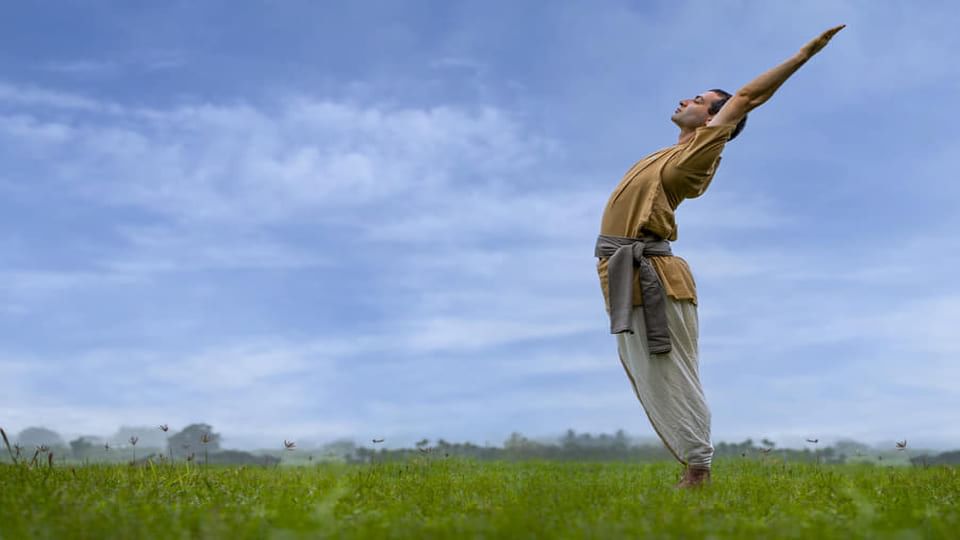
Table of Contents
#1 What is an asana?
#1.1 Asanas and emotions
#1.2 Asanas and awareness
#2 The science of asanas
#2.1 84 asanas to attain
#2.2 Yogasanas – creating health, joy and blissfulness
#3 Asana Siddhi
#3.1 Asana mastery and perception
#3.2 Ease and stability – the third limb of yoga
#3.3 Creating a device to receive the divine
#4 Fine-tuning your asanas
#4.1 Flexibility during asanas
#4.2 The sequence of the asanas
#4.3 Why you shouldn’t speak during asanas
#4.4 Breathing easy during yogasanas
#4.5 Why focusing on the breath is essential during asanas
#4.6 Why yogic practices are often done in sets of three
#4.7 Closing your eyes
#4.8 Toe to toe
#4.9 Heel to perineum
#4.10 Asanas: Exploring how the body and mind work
What is an Asana?
Sadhguru: An asana is a posture. There are innumerable postures your body can take. Among these, certain postures have been identified as “yoga asanas” or yogasanas. “Yoga” means that which takes you on to a higher dimension or higher perception of life. So, that kind of posture which leads you to a higher possibility is called a “yogasana.”
Asanas and Emotions
You may have noticed that for different mental and emotional situations that you go through, your body naturally tends to take a certain posture. If you are happy, you sit one way. When you are unhappy you sit another way. When you are peaceful you sit one way, if you are angry you sit another way. Many times, you can tell what is happening with someone by just observing the way they are sitting, have you noticed?
Based on this, conversely is the science of asanas – by consciously getting your body into a certain posture, you can also elevate your consciousness. You can change the very way you feel, think, understand, and experience life by sitting in a particular way.
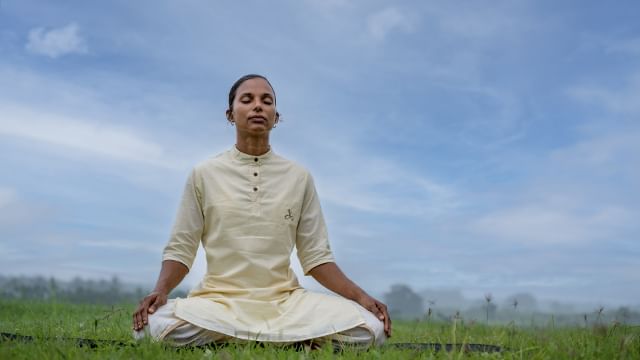
Asanas and Awareness
Yogasanas are not exercises. They are very subtle processes of manipulating your energy in a certain direction. It needs to be done with a certain level of awareness. There are various levels of doing asanas. You can practice asanas just physically, or more deeply, being aware of the breath, sensations, reverberations, being aware of the nadis, or with appropriate mantras. You can even do asanas without moving a limb. That is also possible.
The Science of Asanas
The science of asanas is known as hatha yoga. “Ha” means sun, “ta” means moon. The first process of yoga is to bring balance between the masculine and feminine in you. Otherwise there will be no scaling of consciousness. This is why Shiva is known as Ardhanarishvara – one half of him is a woman, another half of him is a man. He is a man and the very embodiment of manhood.
At the same time, he is also woman, because without bringing this balance, without cultivating these two dimensions within us, there is no reaching towards the peak, there is no question of a human being flowering to his fullest possibility. That is why the first dimension of yoga that you practice is hatha yoga. That means the yoga of the sun and the moon is bringing balance between the masculine and the feminine. That is the first step to take.
84 Asanas to Attain
Among the Yogasanas, there are 84 basic asanas through which one can elevate his consciousness. When we say 84 asanas, do not think of them as just 84 postures. These are 84 systems, 84 ways of attaining. Out of this, if you have mastery over even a single yogasana, everything that is worth knowing in the existence can be known.
Yogasanas – Creating Health, Joy and Blissfulness
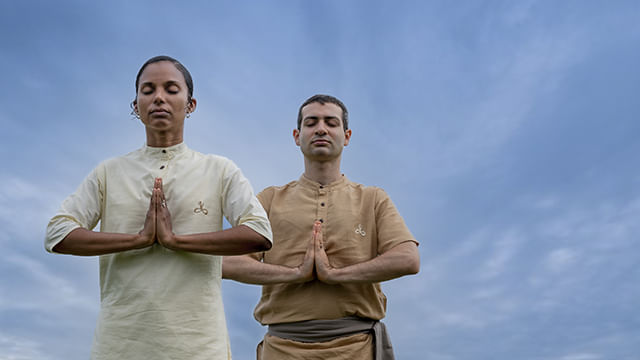
Right now, when you are trying to do hatha yoga, the biggest barrier is the limitations of your body. In fact, whatever human beings want to do, the biggest barrier is their body and mind. What should have been a stepping stone has turned into an obstacle, simply because they have not explored it considerably.
After a profound and thorough exploration of the human system, the yogic system identified 84 asanas as yogasanas, 84 postures through which you can transform your body and mind into a great possibility for your ultimate wellbeing. Most other spiritual processes talk about putting down the body because the body is an obstacle. If you want to sit and meditate, your legs tell you, “I need to stretch. I need to walk.” When we ask you in the morning to stretch your body, you say, “No, I want to rest.” If you do an asana and we ask you to stretch, you say, “No, I don’t want to stretch.” But if we ask you to sit unmoving, your body wants to stretch. Likewise, it has to eat, it has to sleep, it has to relieve itself – the body needs so many things.
Taking charge of your life
The body is a constant manifestation of various levels of compulsiveness, depending upon the type of information that has gone into the system. The information that is imprinted upon your physiological system is what we refer to as the karmic body. This information determines how much compulsiveness you suffer from, and how much freedom you naturally enjoy within yourself.
In hatha yoga, we are not concerned about who our fathers and forefathers were, what kind of genetics and karmic substance we received from them, and what we have imbibed in the process of living. It does not matter what has happened until this moment – we have decided to take charge of our life.
In the Indian tradition, if you are a serious practitioner of yoga, no astrologer will want to make a prediction for you, because even he understands that you have taken charge of your life. This is what a yogasana means – you are taking charge of your life. You are transforming your body and mind into a possibility in your life. It is becoming a passage, not a block.
The process of transforming the body, changing the texture of the body, changing the fundamental information in the body, which makes it go in certain compulsive patterns, needs a certain determination, forcefulness, and adamancy. You are not willing to give in to the cycles of compulsiveness. You go the way you want to go.
Creating the right atmosphere
Ha and tha describe sun and moon. Hatha is about bringing a balance between the two. If these two dimensions are balanced within you, naturally, the body becomes a conducive place to live in for your being. If you mess up the place around you, you can move elsewhere. But if you mess up the body from within, you cannot go elsewhere until you die. As long as you live in this life, the body is the abode of your existence.
It is important that an atmosphere is conducive rather than being compulsive. If your home is a very compulsive place, you will feel suffocated. Every situation, every atmosphere is set up for a certain purpose. Your home may be set up for one kind of purpose. The ashram may be set up for another kind of purpose. An industry or a business may be set up for a different kind of purpose. Every atmosphere should serve the purpose that we have set it up for. You must decide what purpose your body should serve. We will do the appropriate yoga for that.
If your idea of a good life is being one step ahead of others, we will do one type of yoga. If you do not compare yourself to others, but you want to find your ultimate potential in terms of activity, we will do another kind of yoga. If all you want to do is dissolve into the ultimate nature of existence, we will do yet another kind of yoga. We can practice yoga in different ways.
Enhancing perception
An individual human being becomes who he or she is only because of what he or she perceives. You are who you are right now only because of what you have perceived in your life until now, and you will be who you will be only because of what you will perceive in future. The whole system of yoga is about enhancing perception.
If you hold the posture right, if your alignment is right, it matches with the cosmic alignment in some way. The 84 yogasanas represent 84 alignments, because existence as we know it now is seen as the 84th creation. The memory of these 84 creations is reflected in our body.
We are trying to release and activate this memory. If one gets into these 84 postures, or if one masters a single posture and approaches the remaining 83 through that, one can know everything that has happened in creation until now, because the memory of that is within one’s system in a codified way. If this memory touches another dimension outside of yourself, it can be activated and ignited.
Yogasanas are a powerful means to connect. Do not forget, yoga means union. Union means two have become one. There are only two in existence – you and the rest of existence. In the rest of existence you may identify individual entities, but essentially, there are only two – you and the rest of existence – because there are only two dimensions of experience within you. You do not know what is up and down in this cosmos. You do not know what is forward and backward. These are all things that we have made up for convenience. Essentially, there are only two dimensions of experience – inner experiences and outer experiences.
Yoga is about creating a union between these two dimensions – inner and outer, you and the rest, you and the other. When there is no “you” and “the other,” when there is just “you” and “you,” that is yoga.
Asanas are a physical form of approaching this ultimate union, because the physical body is the easiest thing to work with. If you try to come to this union with your mind, it will play too many tricks. With the body, at least you know whether it is doing it right or not, whether it is cooperating or not. If you push the mind too hard, it will make you believe all kinds of things and dump you the next day. The body is a more reliable factor. If you work with it sensibly, the yogasanas can definitely lead to ultimate union.
In the meantime, before this alignment with the ultimate happens, by getting into the postures, inner alignment happens, which will naturally create a chemistry of healthfulness, joyfulness, and blissfulness – and above all balance.
Balance is something that modern societies have ignored, and they are paying a huge price for it. Whatever your intelligence, whatever your competence, education, and qualifications – if you do not have the necessary balance, you will not succeed. You will not go very far in your life. The most important thing for people who are seeking to be successful – whether in the corporate sector, in politics, in the military, or any other field – is balance. Only if you have a balance that is not disturbed by external situations, are you capable of making use of the competence and intelligence within you. Otherwise, even the most wonderful qualities that one may have will go waste, simply because of lack of balance. Hatha yoga brings this balance.
Asana Siddhi
People who have taken up hatha yoga as their way of life generally take up one asana for their life’s sadhana. This is known as Asana Siddhi. Asana Siddhi means one is able to sit in a particular way with absolute ease. For most people, whichever way they keep their body, it is not at ease.
If you sit, it is not comfortable. If you stand, it is not comfortable. If you lie down, it is not comfortable. What the hell to do with this? If you give your body to the process of yoga, slowly the body becomes at ease. If you sit like this, it is absolutely at ease. It is not trying to be some other way.
Asana mastery and perception
A thinking mind cannot understand how a man can spend his whole life wanting to sit in a particular way. But everything that can be perceived can be perceived, by having mastery over a single physical posture. What you are calling as yogasanas is just to get this body geometrically in line with the cosmic geometry. If you learn to just hold it right, you can download the whole cosmos. This is yoga. If you simply sit right, everything that’s worth knowing can be known to you from within.
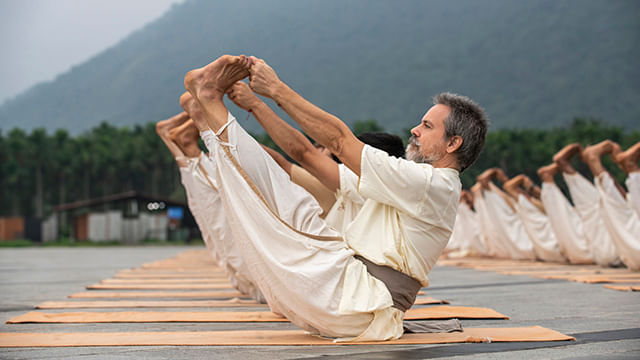
Ease and Stability – The Third Limb of Yoga
Patanjali describes the third limb of yoga, which is the asana, as "Sthiram, Sukham Asanam" - if you are comfortable and stable, that is all the asana is about. Because "comfort" is such a misused word, maybe a closer word to "sukha" in English would be "ease." It simply means that your body is at ease, your mind is at ease, and your energy is at full vibrance and balance. Now you are naturally meditative. You will find full potential to your life.
Creating a Device to Receive the Divine
The reason why hatha yoga has become ugly is because people start taking it like a circus. The way hatha yoga is happening in the West scares me, because all kinds of things are done in the name of yoga that are not yoga. Recently, I was playing golf with a group of young people and they asked, “What do you do?” I just ignored the question and took my shot and kept walking. They asked somebody who was walking with me, and he said, “He teaches yoga.” Immediately, they ran up to me and said, “Can you teach us something that will give us six-pack abs?” I said, “I can give you 14 if you are interested.”
This is not about sculpting your body and showing it off. This is to make the body into a fantastic vessel, a fabulous device to receive the Divine. Hatha yoga is a phenomenal process, but today, many physical therapists and experts are writing books on hatha yoga, making people believe it is an exercise system. It is not an exercise system. Studio yoga is unfortunately just the physical aspect of it. Teaching only the physical aspect of yoga is like having a stillborn baby. If you want a living thing, it needs to be taught in a certain way. In a proper atmosphere, with a certain sense of humility and inclusiveness about the whole process, hatha yoga is a very fantastic process. If I do a two-day hatha yoga program, people will burst with tears of ecstasy simply doing asanas, and that is the way yoga needs to be done.
Fine-tuning your Asanas

Flexibility During Asanas
Questioner: Does the amount of flexibility and the parts of the body that are flexible indicate something about the person’s mental state, their personality, or even their karmic structure?
Sadhguru: That would be a very prejudiced way of looking at life. Let’s not get into judgments about people around you. That somebody is not able to bend or sit on the floor could have many reasons. It would be obnoxious and unnecessary to judge people like that. But to look at the question of flexibility in general – a muscle is useful only if it is flexible. Wherever the body wants 100% rigidity, it produced bones. Wherever it wants 75% rigidity, it produced tendons. Wherever it wants 50% rigidity, it produced cartilages. Wherever it wants total flexibility, it produced muscles. The body structure is made up of different levels of flexibility. If every part of the body was flexible, you would sit like a bean bag.
Some parts of the body are rigid, some are semi-rigid, some are flexible – it is done in an intelligent manner. It should be kept the way the Creator intended it to be. A three-year-old child will be flexible enough to do any asana. You lost this flexibility because of disuse, because you are trying to save your body for the grave. You want to be in a good shape when you go, but you are not in a good shape when you are here.
Increased acidity creates rigid muscles
If there is no injury or damage of any kind to the muscles and they still are tense and rigid, you are probably generating acids in your body. You can notice this – if on a particular day, you are in a mentally tense state, the next day you will find it much harder to bend. If the acid level increases, the muscular structure tends to become rigid.
Emotions and acidity
Rigid muscles and rigid brains are no good. Only when your brain and muscles are flexible, they are useful. If you sit here joyfully, the body will not generate acids. But if you are angry even for five minutes, the acid level in your blood will increase dramatically, to the extent that it is actually poisoning you, and it is this poison that makes the muscular structure rigid. Other than that, lack of flexibility may be cultural, because you are simply not used to sitting on the floor or using your body much. In any case, we cannot judge human beings by their flexibility in the sense, “Tell me which asana you cannot do and I will tell you who you are.”
The Sequence of the Asanas
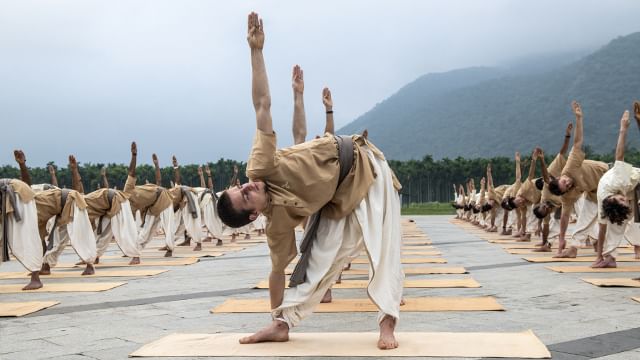
Questioner: What is the importance of the sequence in which we are doing the asanas? Can we change the order?
Sadhguru: The order is not something that you or I invented – it arises from the observation of how not only the physical body but the whole human system functions.
The right postures create comfort
In your system, there is something called skeletal comfort, muscular comfort, organ comfort, and energy comfort. If you sit in a reclining chair, your muscles will be comfortable, but your joints will be strained. You may have noticed that if you travel for some time sitting reclined in a plane or a car, by the time you reach your destination, you will be exhausted. If you sit up straight, this will not happen. If you sit in a recliner, only your muscles are relaxed, but there is a lot of stress on the skeletal system, and above all, on your organs. The vital organs in the trunk are not firmly fixed with clamps and bolts or flanges but hang in connective tissue like in nets. If you sit in a recliner, especially in a moving vehicle, your organs will suffer enormously. In a moving vehicle, you must always sit straight, so that your organs have greater comfort. If you lean back, one organ will press on the other.
Lying down after food
This is why they say you should never lie down right after food. In India, they always told you that you must eat before or just after sunset, and leave at least four hours before you go to bed, because the food should have left the stomach by then. If the stomach is full and you lie down, it presses on other organs. Let’s say you have one or one-and-a-half kilogram of food in your stomach and you lie down for a few hours, depending upon how you are lying, this weight could cause serious damage.
Don’t disjoint your energy
In Hatha Yoga, this organ comfort is always considered. Energy comfort is also considered. Your energy functions in such a way that if you activate one aspect of your energy without activating another aspect of it, your system will become disjointed. There are many disjointed bodies everywhere. Disjointed energy means living a broken life. Somehow, you may manage to live long, but no matter what enters your life, you will not be complete. You may win the lottery, you may get married to the best man or woman in the world, you may pray 24 hours of the day – no matter what you do, you will live a disjointed life.
Asana order activates the system correctly
The order of the asanas is not according to my or your preference, it is the way the human system is made. We need to activate it from one end to the other. Sudden activation of a certain part will lead to disjointedness. Life situations can be such that there is no choice about how to act and no system to it – you may have to jump into action whichever way it comes. But if you have activated your system in a certain way, whatever situation occurs in your life, you will be able to take it without causing too much disturbance to your system.
One can distinctly see this – if you do proper classical yoga, whatever situations you face, they will not leave you scattered. This preparation creates a certain integrity in the system. So the order of asanas is not by choice, it is according to the way the human system is structured.
Why You Shouldn’t Speak During Asanas
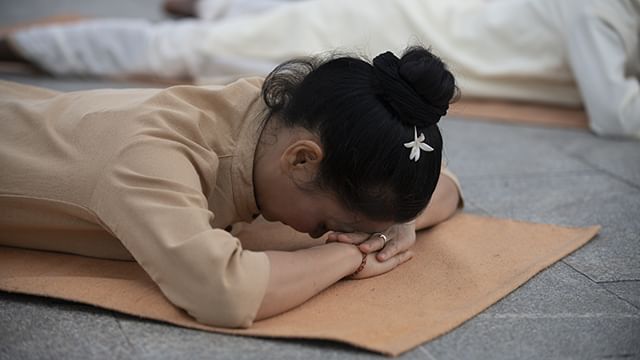
Questioner: Why should we not speak when doing an asana or correct others while they are in an asana?
Sadhguru: An asana is a dynamic way of meditating. Because you cannot sit still, you do something else to become meditative. To take you back to the Yoga Sutras – Patanjali said sthiram sukham asanam. That which is absolutely stable and comfortable is an asana. This means your body is at ease, your mind is at ease, and your energy is vibrant and balanced. Asanas are a preparatory step to come to a state of being naturally meditative. In a way, asanas are a dynamic way of meditating. To think that when you are meditating, you can have a conversation is ridiculous. The same goes for asanas. Speaking triggers a number of changes in your system. You could check this yourself. First sit quietly and check your pulse rate. Then speak intensely and check your pulse rate – it will be very different. The pulse is just one example. Speaking not only changes the physiological parameters – even the energy parameters change dramatically. Above all, without focus, how to do an asana?
Speaking can cause serious imbalance
Once, I was invited to speak in a yoga studio in the US. This lady is an Isha meditator and she had been a yoga teacher for many years. When I came to her yoga studio, music was playing, and she was in ardha matsyendrasana, talking non-stop into a microphone to the group. When I saw this, I wanted to leave, but she recognized me, said “Hi,” jumped up out of the asana, and came towards me. I took her aside and told her this is not the way to teach yoga because it brings serious imbalances to one’s system, and it turned out that she actually was suffering from them.
She gave up teaching after some time, and these issues disappeared. There should be no talking while doing an asana, and no going into any asana whenever you feel like it. I have seen people doing some asana during a bathroom break, because they want the world to know that they are doing yoga. This is silly. If you are able to sit without the need to run to the bathroom, without the need to talk to anyone, without the need to drink anything – that is a good advertisement for you if you are doing yoga. You do not have to get into a posture to tell everyone that you are doing yoga.
Can disturb focus and stability
As a rule, you never ever speak in postures because focus, breath, and what happens to your energy system are most important. And above all, asanas are a preliminary meditative state. You cannot talk in your meditation. If you speak while doing an asana, you will disturb the breath, the mental focus, and the stability of your energy system.
Conscious corrections avoid damage
To the question of corrections – in a way, physically correcting someone would amount to using props. If the teacher makes the corrections clear, people should be able to consciously correct the asana. Otherwise, later, they will make the same mistakes again. Another aspect is, if they are already in a certain state and you try to physically correct the posture by touching them, you could cause damage. To give an example – just moving my finger involves so many things. My muscles, ligaments, skeletal system, mind, and energy have to work in a certain way. Suppose you hold my finger and move it, it is a completely different matter. So the teacher should tell you until you understand how it should be done, but you should make the effort to do the correction from within.
Breathing Easy During Yogasanas
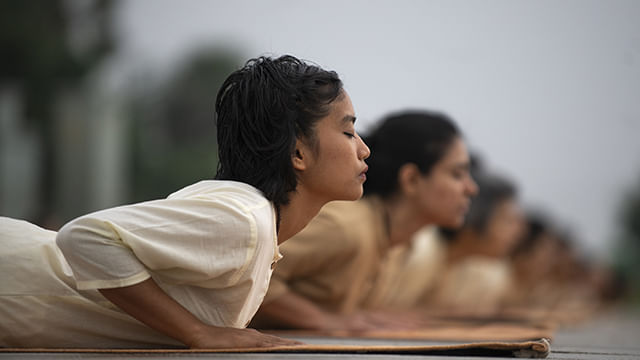
Questioner: Sadhguru, people who come to the yoga class with experience in aerobics or other types of exercise tend to breathe through their mouth while doing yogasanas. Does it make a difference whether we breathe through the nose or mouth? And why should we breathe slightly deeper than normal?
Sadhguru: If you are running at a certain pace, there is a tendency to open your mouth because breathing through your nostrils may not be sufficient. But you never ever breathe through your mouth during asanas. This is not an aerobic exercise – asanas are about building internal strength of the organs and the whole system. Within a few weeks of practicing asanas, naturally, your system will become more capable and your pulse rate will decrease.
Nasal passage purifies and adjusts air
Breathing through the mouth is both unaesthetic and unscientific. You should always breathe through your nasal passage – except in emergencies. If you are just born and they hold you upside down, or you are running a marathon and your pulse rate goes beyond a certain level, or it is your last breath and you want to live for one more minute – then it is all right. Otherwise, always breathe through your nostrils because the nasal passage is there for this purpose – make use of it. There are many benefits to this. One is the purification of the air. Another is that the temperature of the air gets adjusted to your body temperature before it enters the lungs, which is important.
Build up your ability to breathe
In yogasanas, there is absolutely no necessity to breathe through your mouth. You should never push yourself to the point where you have to open your mouth. You must steadily build it up in such a way that your ability to breathe keeps increasing. We say you should breathe slightly deeper than normal because otherwise, if you go into an extreme position and I say “breathe normally,” you will not get enough oxygen and after some time you will gasp. Any gasp is an aberration in the breath. Any aberration in the breath naturally has an effect on various aspects of the body.
Air temperature and mixture
If you breathe in hot air, even if you are at sea level and there is enough oxygen, you will gasp as if you were in high altitude. The human body is comfortable at a certain temperature and it needs a certain air mixture. When I used to ride my motorcycle across the country and I would go up a mountain, from about 4000-5000 feet above mean sea level, the oxygen becomes less and the engine starts behaving differently. Since I always wanted the same level of power, I would stop, open up the carburetor, make the necessary adjustments, and only then ride on. If you come down to sea level, the engine starts knocking and you have to adjust the cylinder head again.
Bringing the body to ease
Recently, I was at the Volvo truck plant and they were showing me the electronic instruments that are attached to the engine nowadays. It detects the efficiency of the firing inside the internal combustion engine, the fuel temperature, the oil temperature, and if there is any small aberration, it informs the driver that this is what is happening. The driver may not be educated enough to make use of this information, so there is another computer which is correcting all these things. For a truck that is lugging up to 130 tons, even a small change in engine performance will translate into a big overall performance drop.
This is just a small imitation of what your body always does. Even a small change in the air temperature will affect it, but the body has correction measures if you are breathing properly. It will correct itself for the rareness of air and for even a small change in the air temperature.
Benefits of building your system
This time when we went to Kailash, we were at an altitude of over 16,000 feet for almost eight, ten days. Except for the Sherpas who always live in that altitude, I was the only one who did not take altitude-sickness medication, even though all the other participants were practicing more yoga on a daily basis than I do. But if you build your system over a period of time, you can enjoy the benefits on all levels, all the time – not only in high altitude. If the body comes to ease, the other possibilities open up.
If the body is not at ease, the other possibilities will not open up because everything is focused on making the physical part right.
Creating ease to explore other dimensions
This is what yoga is about – you want to bring your body to such a state of ease that you do not even know whether your body exists or not. You cannot forget the parts of your body that hurt right now. You can only forget what is at ease. To bring the body to such ease, you must breathe slightly deeper than normal, and over time, in any asana, if you are in the perfect posture, your breath should become normal. If your body is in good shape and you are within a certain age range, after about 12 to 18 months of intense practice, you will come to a point where in a full asana posture, there will be no need to breathe deeper than normal anymore. Just the normal breath will be more than enough, without gasping. If you remain in the full posture for one minute and there is no aberration in your breath or your pulse rate, it means your body is coming to ease. If it comes to such a state of ease, there will be no dis-ease. And if there is no state of dis-ease in you whatsoever, then the body has energy to explore other dimensions of life. Otherwise, the body keeps you busy for the rest of your life.
Why Focusing on The Breath is Essential During Asanas
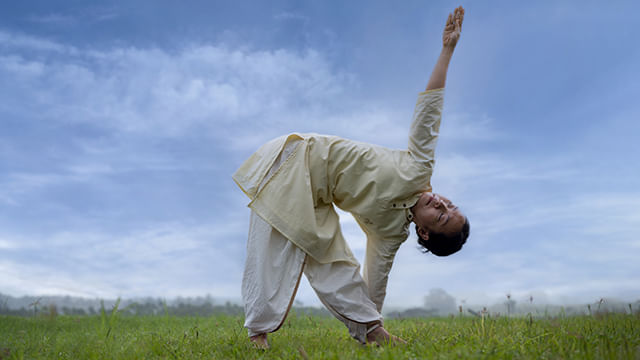
Questioner: Why should we focus on the breath during asanas?
Sadhguru: Your mind and emotions need a single object to focus on. If both of them stay with the same object, you are at maximum ease. If your body goes in one direction, your mind goes in another, and your emotions go in yet another direction, you will be struggling. Let’s say you have a job that you are very involved with, a family at home, and an affair on the side, you will be in a lot of mess – never at ease. Only if your body, mind, and emotions are focused in one direction, you will be at total ease.
The reliability of the breath
Nothing and no one – neither your job nor your wealth nor your family nor your love affair – are as reliable as your breath. As long as you live, it will always be there. It is the most steady and reliable thing to focus your mind on. If while doing an asana, you do not focus your mind onto the breath, it will go all over the place. Therefore, focus on the breath.
If I take away your breath now, you and your body will fall apart. It is your breath which holds you and your body together. This kurma nadi, as we call it in yoga, is like a thread that ties you and your body together.
The link between body and breath
If you constantly stay with your breath, if you really travel with it, one day, you will understand where you and your body are linked. Once you know this, you can hold your body at a distance, and all your trouble and suffering will be over. All the trouble and suffering in your life arise from your body and your mind. If you can hold your body and your mind at a distance to yourself, this is the end of suffering. And only when there is no fear of suffering, a human being will dare to explore his life at full stride. So, being with the breath is very important.
One thing is your mind has a steady companion to stay with. Anyone may leave you, but your breath will not leave you until you die. And another thing is it will transport you to a place where you and your body are linked. If you don’t want your life to be determined by multiple factors of compulsiveness, if you want to do or undo your life by choice, it is important to know this place.
Why Yogic Practices are Often Done in Sets of Three
Questioner: Yogic practices are often done in sets of three. Is there a reason why?
Sadhguru: There are many ways to look at this. This is a dialectical culture. A story will say one thing, but it means something else. It is intentionally structured that way to evolve our logic. If you approach everything in life 100% logically, you will be very crude. Somewhere you have to touch the gray. If everything is black or white for you, no one can be with you. You think you are logically correct but no one can stand you because it is gross logic. So we evolved another kind of logic.
The limits of logic
In modern science, they call it “fuzzy logic,” which is a good way to describe it. But this is more than fuzzy logic – this is dialectical culture. Most Asian countries and large parts of Africa are dialectical cultures, but here in India, we evolved this into a completely different process, particularly using it to describe anything spiritual. Dialectical cultures expressed things not 100% logically. On the surface, it looks like a fantastic story. But if you dig deep enough, there is logic to it.
You know, yoga started with Adiyogi, and one of his names is Tripurantaka. I will cut the story short because with Indian stories, even a sub-story will last for days, and this is intentional, because the idea of the story is to take you logically into an illogical realm. Otherwise, it is very difficult for a human being to rest your logic because that is the only thing that has seen you through life till now.
If I say, “Rest it. Surrender. We will do something with you,” you may say, “Yes,” but you will hold on to your logic. If something does not fit into your logic, your mind will naturally reject it. So the story logically takes you to a place beyond your present level of logic. I will not tell you the whole story because that would take a whole day.
Conquering three dimensions
There was a rakshasa king. Rakshasa is generally translated as demon, but they are not necessarily demons. They are a different kind of people who do not subscribe to the laws of society. A rakshasa is one who is ruled by his own passions, his own lust, and his own needs. Conquest, rape, and grabbing things are normal for him. This rakshasa king became very powerful, so powerful he built three cities floating in the sky. He ruled these cities and whenever he wanted, he came to the earth and ravaged it. There was no competition for him. He was such a warrior and his armies were so strong, no one could stop him. He terrorized all the others – human beings and gods.
At that time, the god population in the country was more than the human population. We had 330 million gods, even then, and not that many people! That many gods and yet this man had no sanctity for anything. He just ravaged everything that he saw. No one could kill him; no one could conquer him. They called all the devas. All the heroes went to fight against him, but he not only vanquished them, he disgraced them in every possible way. He made sure that he was the power.
At that time, Shiva had his eyes closed. They went to him and pleaded for years, but he did not open his eyes – he was somewhere else. Then Vishnu found a way to make him open his eyes and they told him, “Only you can stop this man.” But the rakshasa had taken a boon that no individual city of his could be destroyed by any army. Shiva saw that he could not shoot down these cities individually – he had to shoot down all three at once. So he shot a single arrow that went through all the three cities and they fell down.
Life happens between threes
Tri-pura means “three cities.” Tripurantaka means “one who ended Tripura.” The story of Shiva demolishing all the three cities with a single arrow refers to the three fundamental dimensions of who you are. This can be expressed in many different ways. In terms of qualities, these three dimensions are called tamas, rajas, and sattva. In terms of physical manifestation, we call them pingala, sushumna, and ida. These three nadis are the manifestation of who you are. Then there are the three forces earth, moon, and sun. And the three dimensions of one’s existence here: past, present, and future.
Essentially, life is happening between these three. You can see it as past, present, and future. Or you can see it as ida, sushumna, and pingala. Or you can see it as earth, sun, and moon. If you try to conquer only one out of the three, you will be on an endless ride because the three are internally one. In yoga and in spiritual process, a lot of people are trying to take charge of only one thing, which is a desperate endeavor.
Victory requires conquering all three
The message is: unless you shoot all three of them at once, you will never be victorious. It is a spiritual message given in an elaborate story. How he became a Tripurantaka is a whole book by itself. How he fought the Tripura, the many weapons he used, what all happened – all these things describe the struggles of a human being trying to conquer one aspect of his life. Someone wants to conquer his mind without conquering his energy – he can try as hard as he wants – it is not going to happen. Someone tries to discipline the body without taking charge of the mind and energy – do what you want, it is not going to happen. Mind, body, energy; sun, moon, earth – all these are three. Unless they are shot with a single arrow, they will not fall.
Closing Your Eyes
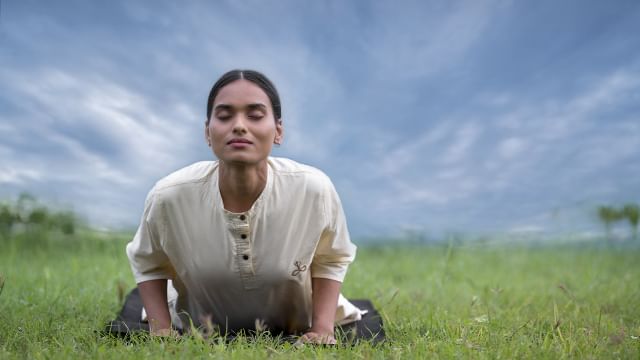
Questioner: Sadhguru, why should we keep our eyes closed in most of the asanas?
Sadhguru: If you close your eyes, the world disappears – unless you have your own false world in your head. Right now, I am looking at you. If I close my eyes, you are gone for me. Unless your imagination is running wild because you have no control over it, if you close your eyes, the world is gone for you.
Disengage and internalize
When you do an asana, you want to internalize everything. One basic step towards any internalization is to close your eyes. If you eat something very good, if something hurts, if something is nice, if you really want to experience something, you close your eyes. This happens naturally when you want to internalize something, because out of the five senses, your vision is the most outwardly engaging process.
Best way to shut off the world
If you lose your vision, you lose 50% of your engagement with the world. The other four senses – smell, touch, taste, and hearing – together make up for the remaining 50%. If you lose your vision, your sense of hearing and your sense of smell will improve, but fundamentally, especially for a human being, vision is the most dominant sense.
By contrast, a dog for example perceives the world through its sense of smell. It knows who you are not by looking at you but by smelling you. But for a human being, since your vision is the most dominant sense for you, once you close your eyes, half the world is shut off. So, internalization works best when your eyes are closed.
Toe to Toe
Questioner: Sadhguru, why should the big toes or heels touch in certain asanas?
Sadhguru: When you bend forward, your heels should always touch because the muladhara should be tight. Otherwise, bending forward, there is a natural movement towards the muladhara, which we want to arrest. In a way, the sole of the foot is a minor manifestation of the whole body. If the toes touch, suddenly the whole system functions differently. You will see in India, if somebody dies, they will take an organic string and tie the big toes together as this prevents certain things from entering the system.
Creating a complete circuit
You do not always know what atmosphere you are in. When the big toes touch, you do not take in what is around you, plus you become a complete circuit by yourself. You are anyway a full-fledged life, though most human beings experience themselves as half a life. If they do not have certain things, they will feel empty.
One aspect of yoga is to set up your energies in such a way that if you sit here, you are complete by your own nature – you do not need anyone or anything to make you complete. If you interact, it is a contribution, and not a seeking to fulfill yourself.
Establishing your wholeness
This is a clear way of setting yourself up in such a way that you are not a vested interest – not out of morality or ethics but by your own nature, because you are complete within yourself. To establish this sense of completeness, it is important to keep the toes together. In certain asanas, either the big toes should be together or your muladhara should be supported. That way, you are constantly working towards making yourself into a complete process, so this sense of incompleteness, this sense of not being whole will go away.
Heel to Perineum
Questioner: In asanas such as ardhasiddhasana, vrikshasana, and yogamudra, the heel should touch the perineum. What if this is anatomically not possible or if it slips?
Sadhguru: If you partially sit on the heel, it will always touch this three-fourth of an inch space that the perineum is. Whether the heel slips or not depends on how comfortably it goes to the perineum. Once you become more flexible, it will stay there. When you do janurshirsasana for example, do not move the heel away for your convenience. The important thing that you want to create in these asanas is full pressure on the muladhara.
Asanas: Exploring How the Body and Mind Work
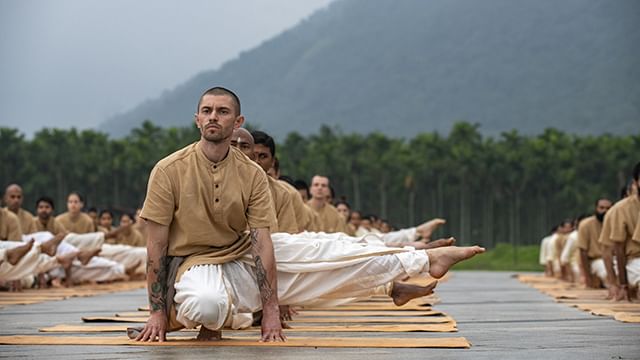
Questioner: Namaskaram, Sadhguru. Whenever I try to stop any negative emotion like anger, it only becomes stronger. How can I get a grip on how my mind works?
Sadhguru: If you try to stop what you don’t want, only that will happen. This has always been the nature of your mind and the human mind as such. The whole system of yoga is about experientially exploring the nature of your body and your mind.
When you get up in the morning and do your asanas, it is not because it is a stretching exercise, as a whole lot of idiots across the planet describe it. Yes, you have to stretch to do it, but fundamentally, it is an exploration of your body and your mind. Because the biggest problem in your life is, you are trying to live here without having a grasp of the two basic vehicles without which you cannot go through this life – the physical body and the mind.
Understanding the vehicle
How comfortably you travel through life depends on how deeply you have grasped your body and your mind. For the journey to be comfortable, the vehicle has to be good, and you must understand the vehicle – how it behaves, what it does, and why it does what it does. This is not enlightenment – this is necessary even if you only want to live an ignorant life. They used to say, “Ignorance is bliss” – if that was true, the world should be blissed out by now.
An experiential exploration
Even if you have chosen to be ignorant because you think it is blissful, to walk through this world, you must have a grasp of this body and this mind. Otherwise, doing anything is a problem. I will not go into this further intellectually, because then you would get all wound up. That is why the yogic system is an experiential exploration without trying to go into it intellectually.
When you do your asanas, you explore the nature of your body and your mind. If you move your fingers in a certain way, your mind will function accordingly. Everything that you do with your body does something with your mind. You will not come to this understanding by reading a book. It will come to you only by exploration. If you close your eyes and try to forcefully remove something from your mind, you will never be successful. This is the most basic and at the same time the most important realization that everyone needs to come to. Without this realization, you will make a complete mess out of yourself. If you are not so sharp in your head, it will be okay. But if you are sharp, you will cut yourself all over, and before anyone can save you, you will be mutilated.
Every day, such mutilated human beings come to me and say, “Sadhguru, I’m interested in enlightenment.” First fix the wounds, or at least stop causing further wounds, because you have a very sharp knife.
Exploring the fundamentals
Even to shave themselves, a whole lot of men cut their faces. I have seen people bleeding in the face because they want to cut themselves close and it gets closer than planned. Understanding the fundamentals, grasping as to how your mind functions, does not come from an intellectual analysis – it is an exploration. What you need to do is, hold your body in one posture, and see your mind functions in a certain way. Hold your body in another posture, and see your mind functions in a different way.
Hatha Yoga is preparatory
If you stay in an asana and breathe properly, as you go through this process, the mind will go into various states. This exploration is the most fundamental aspect of yoga. Hatha Yoga is not the peak – it is preparatory. If you try to go to the peak without that preparatory step, you will probably crash.
At least 80% of humanity will not be able to do any kind of meditation in their life unless they do some kind of physical preparation. The very way they sit, the very way they move their body, it is clear that they cannot meditate, no matter how hard they try. Some amount of physical preparation is needed, because body and mind are not two separate things – or is your brain outside your body? What happens to your little finger happens to the brain. What happens to the brain happens to the little finger. It works both ways. The brain is not a separate entity by itself.
Doctors have learned about the body by dissecting dead bodies – if you open a dead body and cut out different organs and keep them in different places, it is all separate. But that is not how your body is – it is all one. Only to a discriminating scalpel it is separate, but for a living human being, it is all one. That is why the yogic system is designed the way it is.
What you resist will manifest
As an experiment, try to resist the things that you want. You will see they will manifest strongly within you. If you want something to happen, try to not make it happen. It will definitely happen. That is because you are in a state where when you want to put your mind in first gear, it goes into reverse gear. This is not the best way to do things, but you could try this to understand that this is how it is right now – if you resist something, only that will happen.
Doing your sadhana – It works!
From tomorrow, get up at five o’ clock in the morning, have a cold shower, and start your sadhana at 5:30, every day. After some time, so many things which were a problem in your mind will be gone. Just do your hatha yoga for an hour a day – it works. But if you want to understand how it works, what the mechanism and the process are, it takes a lot of effort and time. To make it work does not take much. But if you want to know the whole intricacy of what makes it happen, why it happens the way it happens, why a particular asana has a particular effect, then it is lifetimes of study.
Those who want to benefit from the technology should simply learn to use it. For those who want to know the basis and the science behind the technology, it is lifetimes of work. It took me three lifetimes to understand how it works. I am assuming you are smarter than me because you have come to me, and after all the things I do – no sweetness, no promise of heaven, no miracles, not even a pleasant word, no hug – you are still here. So, assuming you are smart, it is a lifetime of work.
Still more on Asanas
Sitting Still – Settling the Mind and Body Sadhguru answers a question on what it takes to sit still for long periods of time, and speaks about the importance of settling the mind, body, emotion and energies.
What Kind of Clothes Should You Wear For Yoga? Sadhguru looks at the importance of the right kind of clothing during sadhana, and the need to avoid metallic objects on the body at this time.
Why An Empty Stomach is Essential for Hatha Yoga Practice Sadhguru answers a question on why Hatha Yoga should be practiced on an empty stomach, and explores the nature of the body and how Hatha Yoga influences it.
Why You Shouldn’t Drink Water While Practicing Yoga Sadhguru looks at the importance of maintaining the right body conditions during hatha yoga, and explains why we shouldn’t drink water during practice.
Editor’s Note: Isha Hatha Yoga offers an annual 21-week Hatha Yoga Teacher Training as well as several intensive hatha yoga modules, taught by teachers across the world.
Editor’s Note: Subscribe to the official Sadhguru YouTube channel to watch new videos every Monday, Wednesday and Friday.
POSTED IN: Hatha Yoga & Asanas
Sadhguru Quote

